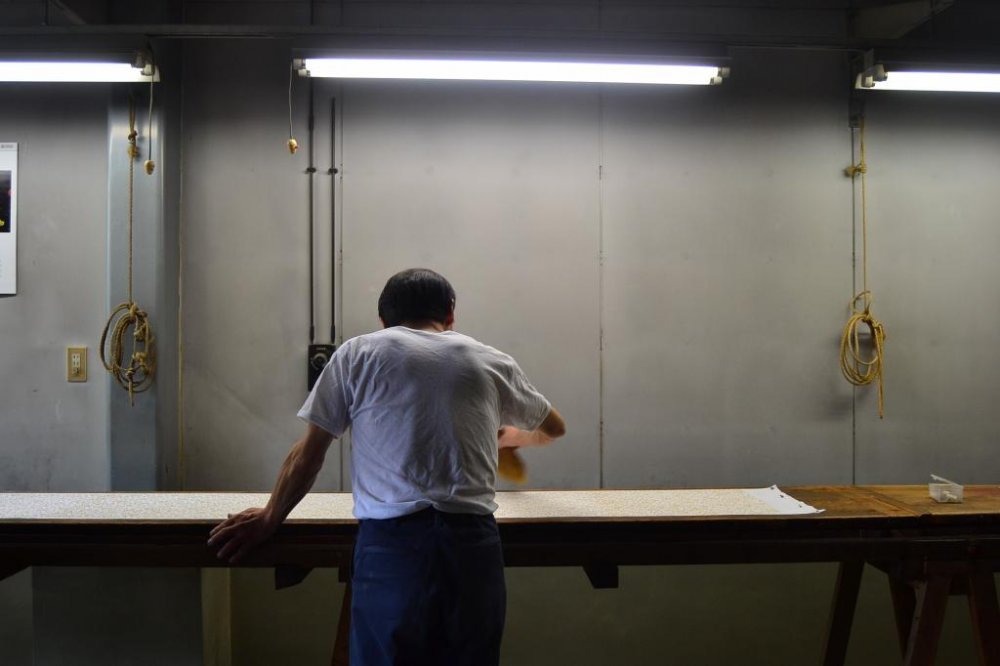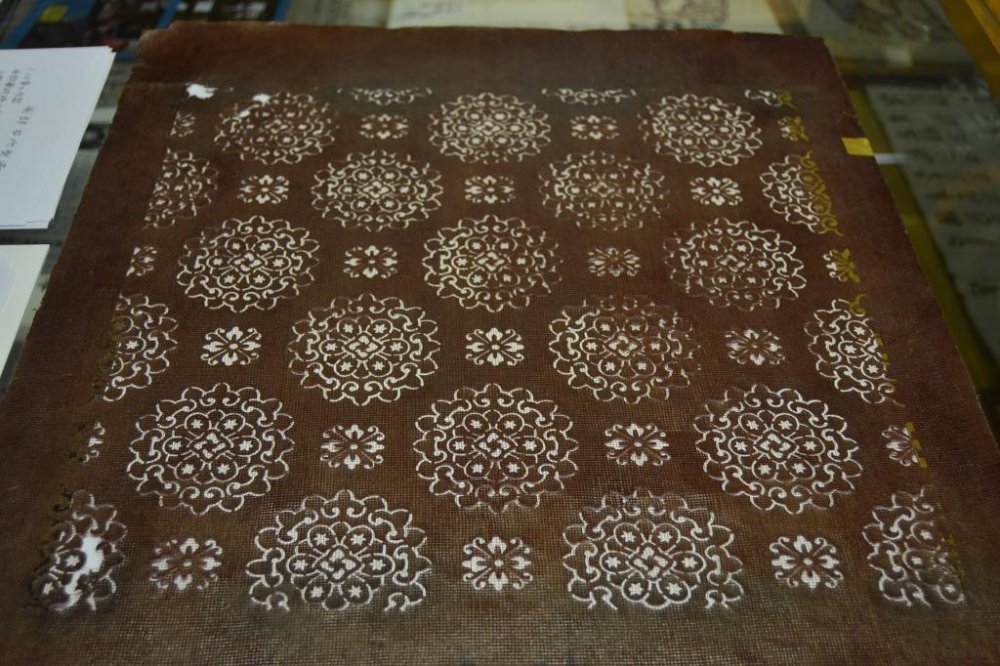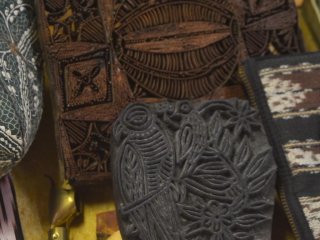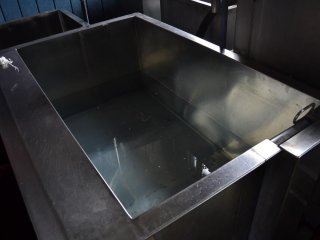Nambu Dye Shop has preserved its traditional style of clothing for more than 300 years. At the shop's gallery and workshop, it’s possible for us to see the production process of Nambu dye. Nambu dye is still manufactured using a traditional method. Basic tools that are used for making the pattern are a kata, a water resistant template made from Japanese paper and an astringent extract from persimmons, and rice glue as the ‘ink’. Natural colors that are used, notably aizome, or indigo blue dye, have a strong historical connection with Nambu dye. Come and see the fascinating process of making Nambu Dye at this historic shop!
- 1 min read
The Making of Nambu Dye
Traditional process for dyeing cloth

By Sarashanti
Community writer

Craftsman who remove bubbles inside the rice glue using a brush.

Kata, a traditional template used to create patterns on the plain white fabric.

Porcelain doll from the mid-Edo period on display for several weeks on the second floor in order to celebrate boy’s day or tango.

Tools that are used for dyeing using another method from Indonesia.

An aluminum vat that is used for washing away rice glue on dyed fabric.

Clothes originally worn by a high ranking military figure.

Mid-Edo period doll representative of a Japanese prince, clothed in silk garments that were made in China.

Rice glue containing lots of bubbles that must be removed using a small brush. Removing the bubbles from the glue helps to keep the design of the final product consistent.

Bamboo sticks placed along the wet fabric that has the design overlaid on it.

Scraping the back of the fabric with a knife to make sure that the rice glue is well absorbed.

Accelerated drying of the fabric above the charcoal burners.

Bamboo sticks that are placed along the fabric to prevent creases.

Rice glue that has been applied to the plain fabric using a template.

Double layer kata.

Old examples of kata which are no longer in use because of wear and tear and size differences between present day people that require larger kata.

Plant that is traditionally used to impart the indigo color to fabric in the dyeing process.

Completed Nambu dye fabrics.

Nambu dye bags that are ready to pick!
Join the discussion
Victoria Vlisides
10 years ago
Beautiful art!
thanks! :)
2 comments in total
Book your trip
Find a nearby hotel
Explore some of the best nearby hotels and deals for the perfect place to stay in Japan.
Top Articles
-
![See Southern Japan with Kirishima As Your Gateway See Southern Japan with Kirishima As Your Gateway]() 1
1See Southern Japan with Kirishima As Your Gateway
Kagoshima - Sponsored -
![Discover Shiga Prefecture: Events at COCOSHIGA in Tokyo Discover Shiga Prefecture: Events at COCOSHIGA in Tokyo]() 2
2Discover Shiga Prefecture: Events at COCOSHIGA in Tokyo
Tokyo - Sponsored -
![Ultimate Japan Car Culture Journey - From Auto Salon 2026 to the Open Road Ultimate Japan Car Culture Journey - From Auto Salon 2026 to the Open Road]() 3
3Ultimate Japan Car Culture Journey - From Auto Salon 2026 to the Open Road
Chiba -
![Exploring Japan Through the Seasons: Three First-Time Classic Tours Exploring Japan Through the Seasons: Three First-Time Classic Tours]() 4
4Exploring Japan Through the Seasons: Three First-Time Classic Tours
Culture -
![Experience Oarai: A Quiet Fishing Town Blessed by the Bounty of the Sea Experience Oarai: A Quiet Fishing Town Blessed by the Bounty of the Sea]() 5
5Experience Oarai: A Quiet Fishing Town Blessed by the Bounty of the Sea
Ibaraki - Sponsored -
![A Hidden Getaway in Yaizu, Shizuoka A Hidden Getaway in Yaizu, Shizuoka]() 6
6A Hidden Getaway in Yaizu, Shizuoka
Shizuoka - Sponsored -
![A Taste of Shiga at COCOSHIGA A Taste of Shiga at COCOSHIGA]() 7
7A Taste of Shiga at COCOSHIGA
Tokyo - Sponsored -
![Spa Resort Hawaiians: A Tropical Escape with a Japanese Soul in Iwaki Spa Resort Hawaiians: A Tropical Escape with a Japanese Soul in Iwaki]() 8
8Spa Resort Hawaiians: A Tropical Escape with a Japanese Soul in Iwaki
Fukushima - Sponsored -
![Japan Pottery Tour: Hands-On Workshops & Artisan Encounters Japan Pottery Tour: Hands-On Workshops & Artisan Encounters]() 9
9Japan Pottery Tour: Hands-On Workshops & Artisan Encounters
Culture -
![Miyoko Schinner: Japan Vegan Tour 2026 Miyoko Schinner: Japan Vegan Tour 2026]() 10
10Miyoko Schinner: Japan Vegan Tour 2026
Food
-
![Tokyo Christmas Market Tokyo Christmas Market]() 1
1Tokyo Christmas Market
Tokyo -
![Guide to Bringing Medicines Into Japan Guide to Bringing Medicines Into Japan]() 2
2Guide to Bringing Medicines Into Japan
Planning -
![The Ultimate Guide to Thrifting in Tokyo The Ultimate Guide to Thrifting in Tokyo]() 3
3The Ultimate Guide to Thrifting in Tokyo
Shopping -
![Your Name: Real-Life Locations in Tokyo Your Name: Real-Life Locations in Tokyo]() 4
4Your Name: Real-Life Locations in Tokyo
Tokyo -
![Shibuya Blue Cave Illumination Shibuya Blue Cave Illumination]() 5
5Shibuya Blue Cave Illumination
Tokyo -
![Nabana no Sato Illumination Nabana no Sato Illumination]() 6
6Nabana no Sato Illumination
Mie -
![Winter in Japan: Your Seasonal Guide Winter in Japan: Your Seasonal Guide]() 7
7Winter in Japan: Your Seasonal Guide
Planning -
![Bad Bunny Debí Tirar Más Fotos World Tour Bad Bunny Debí Tirar Más Fotos World Tour]() 8
8Bad Bunny Debí Tirar Más Fotos World Tour
Tokyo -
![Japanese Urban Legends Japanese Urban Legends]() 9
9Japanese Urban Legends
Culture -
![Tokyo Auto Salon Tokyo Auto Salon]() 10
10Tokyo Auto Salon
Chiba











































